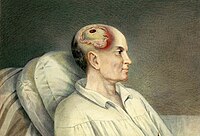
Photo from wikipedia
Abstract Rationale: Septic cavernous sinus thrombosis (SCST) is a rare but life-threatening condition that commonly arises from infections, including paranasal sinusitis, otitis media, and skin infection. Meanwhile, head trauma as… Click to show full abstract
Abstract Rationale: Septic cavernous sinus thrombosis (SCST) is a rare but life-threatening condition that commonly arises from infections, including paranasal sinusitis, otitis media, and skin infection. Meanwhile, head trauma as a predisposing factor of SCST has been scarcely reported. We report a case of SCST complicated by meningitis after minor head trauma, even in the absence of identifiable fractures. Patient concerns and diagnosis: A 77-year-old female presented with diplopia combined with ocular pain and headache lasting a week. She had a recent blunt head trauma 2 weeks before the diplopia onset. The trauma was not accompanied by identifiable skull fractures, bleeding, or loss of consciousness. Neurological examination revealed incomplete ptosis, eyelid swelling, and medial and vertical gaze limitations of both eyes. Gadolinium-enhanced brain magnetic resonance imaging demonstrated multifocal thrombotic filling defects, including those of the cavernous sinus, sinusitis involving the sphenoid and ethmoid sinuses, and otomastoiditis. The cerebrospinal fluid assay result was compatible with bacterial meningitis. A tentative diagnosis of SCST complicated by bacterial meningitis and multifocal cerebral venous thrombosis was made based on clinical, laboratory, and neuroradiologic findings. Intervention: Intravenous triple antibiotic therapy (vancomycin, ceftriaxone, and ampicillin) for 2 weeks combined with methylprednisolone (1 g/d for 5 days) was administered. Despite the initial treatment, carotid-cavernous fistula was newly developed during hospitalization. Therefore, coil embolization was performed successfully for the treatment of carotid-cavernous fistula. Outcomes: The symptoms of the patient including diplopia gradually improved during the 8-month follow-up period. Lessons: Minor head trauma is a rare but possible cause of SCST. Early recognition and prompt treatment are essential for improving outcomes. Moreover, close observation is warranted, even if apparent serious complications were absent during initial evaluations in minor head trauma.
Journal Title: Medicine
Year Published: 2022
Link to full text (if available)
Share on Social Media: Sign Up to like & get
recommendations!